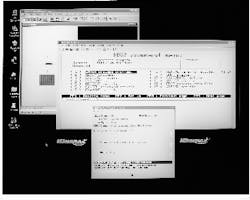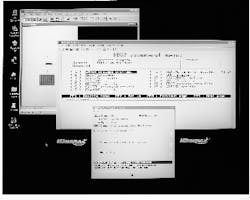Summer doldrums slow down visits at front-end Semicon
Summer doldrums slow down visits at front-end Semicon
Hassaun Jones-Bey Senior Editor
In August, Semiconductor Equipment and Materials International (SEMI) reported a book-to-bill ratio for the semiconductor equipment industry of 0.69 for the previous month. The number means that $69 in orders was received for every $100 worth of product shipped. The July 1998 figure was 11% down from June and 15% down from July 1997. Three-month bookings were down 19% from June and 47% from the previous year.
"The July data confirm a continuation of the softening of equipment orders," said Dick Greene, principal analyst at SEMI. "As has been the case since this downturn began, surplus semiconductor production capacity and the Asian economic situation continue to dampen both the chip and the equipment industries."
The retrospective July data seem to confirm observations made in July by exhibitors at the wafer processing section of Semicon West (San Francisco, CA), who estimated a 20% drop in visitor attendance from the previous year largely due to Asian economic woes and a general downturn in the industry. But a number of exhibitors said after the meeting that the drop in meeting attendance did not seem as bad as they had expected it would be. As it turns out, the estimates of a 20% decline differed by an order of magnitude from the official numbers for both halves of the show, which were 74,412 total registrants (down 2% from 1997) and 26,228 verified nonexhibitor attendees (down 3.4% last year).
Exhibitor attendance estimates tended to be based on sales leads, but attitude may have also played a role in perception. The San Francisco exposition opened somewhat gloomily on July 13 amidst a major slowdown in the transition to 300-mm wafers, some uncertainty about timing for the 193-nm transition, and a lot of people looking for work. Papken Der Torossian, CEO and chairman at Silicon Valley Group (SVG; San Jose, CA), painted a bleak picture of the overall situation, while explaining a 41% drop in sales at SVG for the third quarter of 1998 (ended June 30) compared to the second quarter, as well as a layoff of more than one-fifth of the SVG workforce.
"The semiconductor and related industries continue to go through a very difficult period and many semiconductor equipment industry leaders believe it will not improve any time soon," he stated in a July 20 report of the company`s third-quarter results. "New fab construction or expansion of existing sites has been dramatically reduced. Asian economic conditions have not improved and the implications of low-cost personal computers are impacting sectors of the PC and related businesses." On the positive side, however, SVG announced a new step-and-scan system for deep-UV and plans to ship a 193-nm exposure tool by next year--evidencing an upbeat attitude in the face of adversity that seemed prevalent among Semicon exhibitors.
Despite the fact that a count of sales leads indicated a 20% drop from last year, Susan Bernardi at Nikon Precision Inc. (NPI; Belmont, CA) said she was impressed by the size of the crowd--which was much larger than expected given the difficult economic situation in the industry. The downside of the relatively large crowd, however, was that many of the people in it were either trying to sell something or looking for a job, she said. There was "almost a desperate tone" in some of the people who visited the NPI booth, said Bernardi. At times, the frequent visits from boothless vendors interested in selling as opposed to buying products or services got "a little annoying," she added. NPI introduced a series of upgrades, targeted at its installed base of step-and-repeat lithography systems, that included a PC-based system controller to replace existing minicomputer technology as well as significant improvements in illumination systems, mechanical systems, and diagnostic tools (see photo on p. 55).
Over and above the downbeat economic picture, many exhibitors found enthusiastic responses to new-product introductions. About 55 people attended the show-floor introduction of an electron-beam, raster-scan pattern generation system for 0.18-µm masks by Etec Systems (Hayward, CA). Customer response to new products at Advanced Energy Industries (Fort Collins, CO), which included a fully integrated 13.56-MH¥RF power supply, seemed strong and similar to previous years, according to James Usher, director of the company`s international semiconductor group. A preliminary count of sales leads indicated a 30% drop from last year, but Usher said the actual number of leads may rise when informal contacts with familiar customers are factored in. Many of Advanced Energy`s customers exhibit at Semicon, Usher said. So the lighter crowds may actually have helped Advanced Energy by giving the other exhibitors time to visit the booth.
Product introductions that seemed to target the uncertain conditions included a low-cost, diode-pumped-laser system for marking 200-mm and smaller wafers introduced by Lumonics (Kanata, Ontario, Canada) and a "dual-era" stepper introduced by Canon (Tokyo, Japan) to handle 200-mm and 300-mm wafers as well as 248-nm and 193-nm design rules. As a matter of fact, Canon`s whole approach to the exhibit seemed to reflect the changing economic climate. Last year the Canon exhibit theme of "pushing the limit" included hourly speeches and autograph signings by land-speed record holder Craig Breedlove, along with a rocket car in the booth and Craig Breedlove T-shirts. This year, however, the focus was on customer needs and included detailed product presentations on CDs with professionally produced 3-D graphics.
Unlike the relatively slow pace of the wafer-processing portion of Semicon West `98 in San Francisco, however, traffic at the test and assembly portion in San Jose "was very brisk," according to Carol Tatosian of AB Lasers (Acton, MA). AB Lasers introduced a new wafer marker in San Francisco and a new component marker in San Jose. Schlumberger ATE exhibited new products in both locations--including a critical-dimension scanning electron microscope in San Jose for analyzing production processes--and, in contrast to reports from other companies, may have observed a higher percentage of purchasing decision makers in the smaller crowds, according to Michele Bernhardt.
"Most companies sent 20 people last year, while this year they only sent two," she said. "But those two were the ones we wanted to talk to." o
Several exhibitors at Semicon West `98 focused on improvements to equipment currently in use, among them Nikon Precision Inc., which introduced an upgrade to the Windows NT environment for its customers who currently control their steppers with DEC PDP computers.

